Brussels: Famous for Beer, Chocolate, and Piss. Yes, Piss.
As a little girl, I sat on my grandmother’s lap, fascinated by the tales she spun. I readily believed most of her stories, but the one about a famous statue in a city named Brussels, which featured a little boy taking a piss, seemed highly suspect. I dismissed it as fantasy. More than fifty years later, I rounded a corner in Brussels and came face to face with a statue of a little boy…taking a piss. I hadn’t thought about my grandmother’s yarn for decades, but when confronted with the real thing, memories came flooding back.

In her version, a king’s son had run away and become hopelessly lost in the city. The king offered a reward to whomever found the boy. He also vowed to erect a statue of whatever the boy was doing when he was found. Grandma was almost correct. It was a nobleman rather than a king, but the part about taking a piss was true. The nobleman kept his word. In the mid-15th century, he placed a statue of the boy relieving himself in a prominent square in the center of the Belgian capital. Today it is known as Manneken Pis and visiting it is one of the most popular things to in Belgium.
Fascinated, I planted myself in a corner and watched tourists come and go, each attempting to take the most unique photo. One man positioned himself at the foot of the fountain, tilted his head back, and opened his mouth. Steps away, his wife framed the shot so it appeared the boy was peeing into her husband’s mouth. Disgusted by the moronic behavior of the tourists, I turned my attention to the sculpture. Based on grandma’s story, I had expected an enormous fountain, but Manneken Pis is less than two feet tall. Even stranger, it was dressed in loose white pants and shirt. My grandmother had insisted the sculpture was of a naked boy.
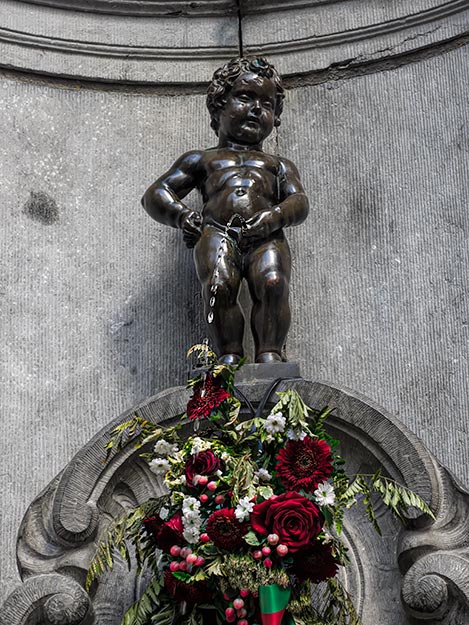
I found my answer on a small sign mounted to the fence around the sculpture, which listed the “calendar of skins.” On this day, he was dressed in the traditional costume of the Philippines to honor the 119th anniversary of Filipino independence. Three days earlier he had been dressed to celebrate the national holiday of Ethiopia. Two days hence, Manneken Pis was scheduled to don a costume marking the anniversary of the founding of Hard Rock Cafe. The tradition of dressing the statue dates back to 1615, when Manneken Pis appeared in a copy of the shepherd’s costume featured in a famous painting of the Ommegang Procession by Denis Van Alsloot. Soon, people, countries, and even businesses were donating costumes and vying for the right to dress the statue for a day. Today, an official schedule is drawn up for the 130 different wardrobe changes that occur each year.
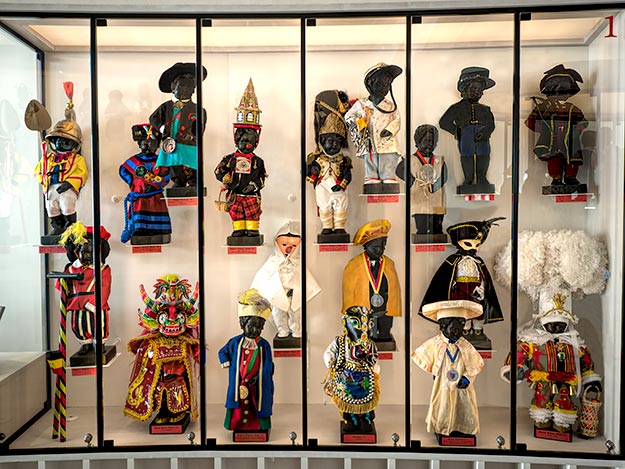
Although dressing religious statues is a fairly common custom, dressing secular figures is much rarer. Manneken Pis may be the only statuette in the world to possess an actual wardrobe of clothes. Of his more than 1,000 costumes, some of the most interesting, elaborate, or historically significant are displayed just a block away at the GardeRobe Museum. Though every continent is represented in the collection, the bulk of the costumes are from European countries. I spotted only three for the United States: a classic red, white, and blue Uncle Sam; a Civil War uniform; and a rhinestone-studded Elvis jumpsuit.
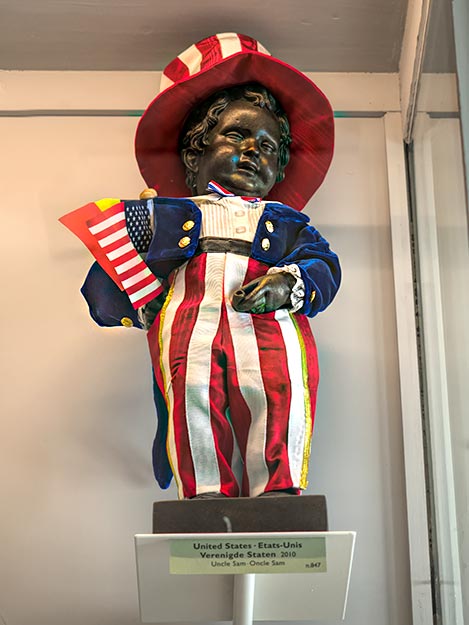
Anyone wishing to present Manneken Pis with a costume must make an official request to the College of Mayor and Aldermen of the City of Brussels. The proposal is passed over to a commission composed of members of the Order of the Friends of Manneken Pis, along with representatives of the city. Donors must agree to use materials of good quality that can be preserved in perpetuity, and costumes cannot represent political purposes, promote beliefs, or be used for advertising purposes (this latter gave me pause, considering the Hard Rock Cafe costume). If the proposal is approved, the donors must create the costume using a pattern that takes into account the difficulties of dressing the statue, including an appropriate slit in the pants for the…uh…piss. The finished costume is formally received at the City Hall by an elected representative, who leads a procession to the fountain, where the official dresser puts it on the statue. Manneken Pis wears his new duds for the rest of the day, after which it becomes part of his wardrobe.

It was at the GardeRobe I learned the most surprising fact of all. The diminutive black statue that everyone flocks to see on the streets of Brussels is a copy. Because thieves have targeted the real one several times between the 19th and 20th centuries, in 1965 authorities decided to move the original to the Museum of the City of Brussels on the Grand Place. The hordes of tourists who jostle and jockey for position on the street corner apparently don’t have a clue that they aren’t even viewing the real deal. Even worse, many flock to see Jeanneke Pis, a knock-off statue of a young girl squatting to urinate that was installed in 1987. There is even a bronze sculpture of a dog taking a leak that goes by the name of Zinneke Pis, though in this case the stream of piss is noticeably absent.

When I’d finally had my fill of pissing statues I wandered back toward the Grand Place, Brussels’ magnificent main square that is surrounded by gilded palaces. On the way, I passed a corner bar with rows of outdoor tables perfect for people-watching. Several customers were sipping drinks arrayed on a long wooden tray that held nine glasses. Some of the drinks, which ranged in color from honey-colored to blood red, were obviously varieties of beer. But the red ones appeared to be wine.
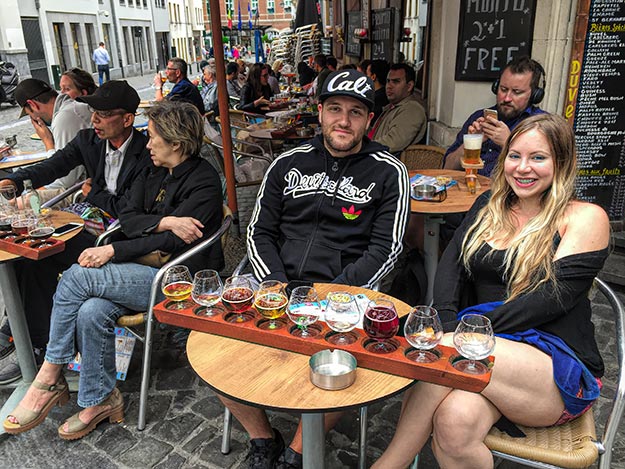
Puzzled by the unorthodox pairing of beer and wine, I asked one American couple about the spread. “It’s called a beer flight,” they explained. “The red ones are beers brewed with sour cherries.” The waitress walked up at that point and laughed when I sheepishly admitted I’d mistaken some of the beers for wine. “On no, we have no wine in Belgium. We have only beer, piss, and chocolates.”
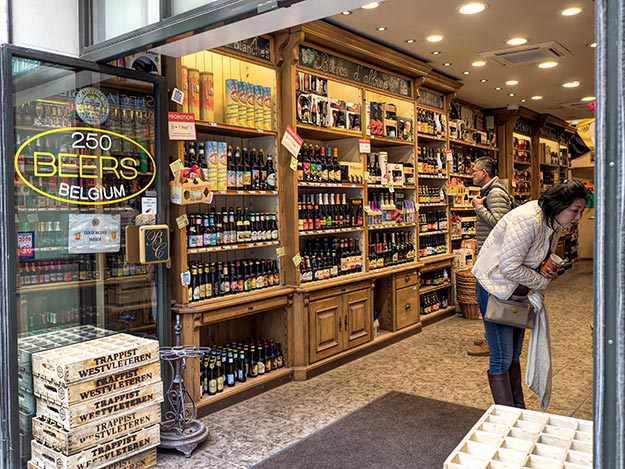
Having already seen the piss and beer, I made a beeline for the Museum of Cacao and Chocolate, where I found chocolatier Henri Snackers stirring up a fresh batch of artisinal praliné. This purely Belgian delicacy is not to be confused with American pralines. The latter are carmelized pecans, covered in a confection made with chocolate and cream. Belgian praliné are chocolate shells (bonbons), with creamy centers made from hazelnut, almonds, sugar, and syrup. After sampling (and swooning over) several of his just-made bonbons, I wandered through the museum, learning about the history, varieties, and production of chocolate around the world.
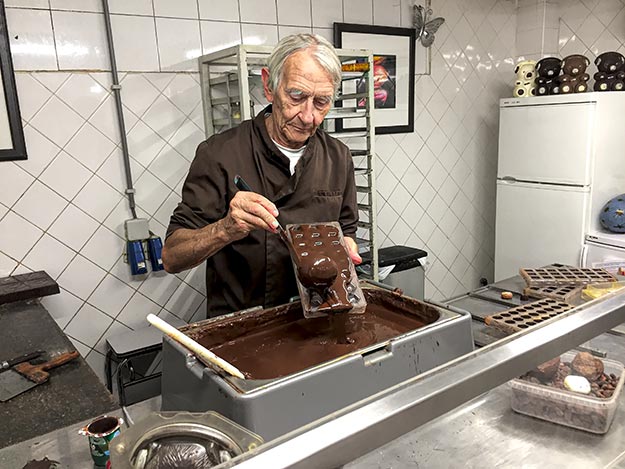
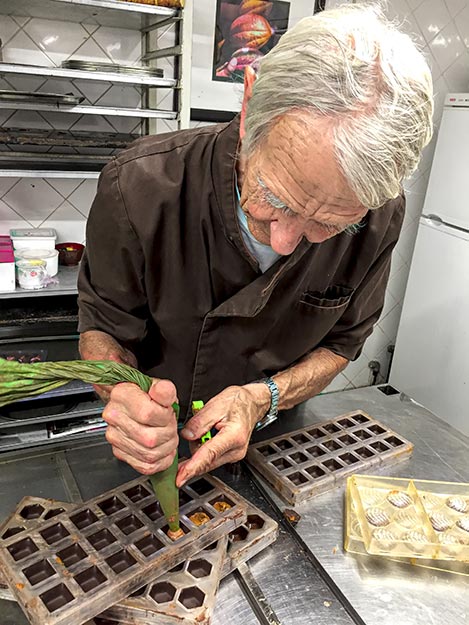
Tucked into a corner I happened upon several tall glass dispensers holding different varieties of chocolate. The most concentrated chocolate wafer, which contained 90% cacao, was extremely bitter. I threw a handful of pure cocoa butter nibs into my mouth to wash out the bitterness and was immediately sorry. They tasted horrible: flat and greasy and obviously better suited as a body lotion ingredient. The white chocolate wafer was better, but not chocolatey enough for my taste, so I moved on to milk chocolate and 70% dark chocolate wafers. I’ve always preferred milk chocolate, so I was very surprised when the 70% cacao dark chocolate turned out to be my favorite. I chalked it up to never before having tasted such high quality chocolate.
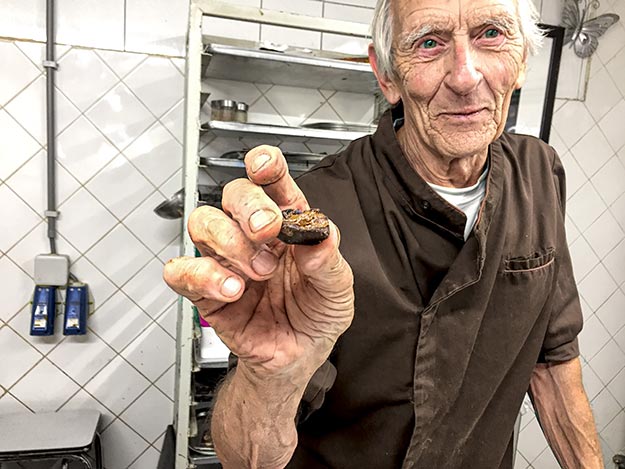
The few samples at the museum were a tease and it wasn’t long before serious chocolate cravings set in. Fortunately, dozens of chocolatiers around the Grand Place awaited. I picked Corné Port-Royal Chocolatier at random, drawn more by the mouthwatering display of chocolates in their front window than by their claim of producing chocolates since 1932.
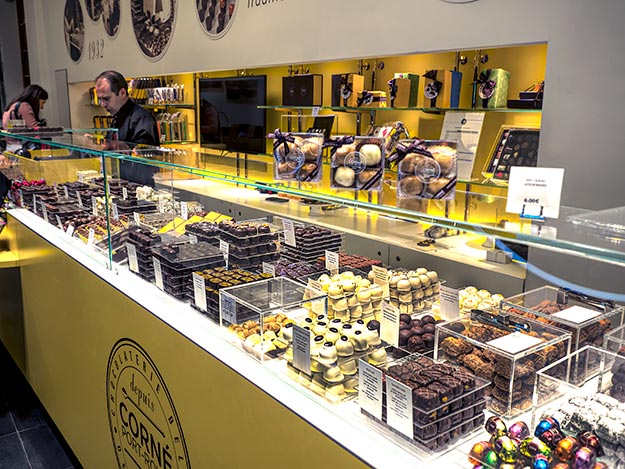
Inside, a glass case offered a wondrous selection. Bonbons, nougats, Marzipan, and chocolate covered nuts and dried fruits. Chunky squares of chocolate flavored with coffee, orange, and raspberry. Cocoa-dusted ganache, white chocolate, even violet chocolate. I agonized over the choices and walked out with a box of 24. For the next two days, I gorged exclusively on chocolate. I don’t regret a single calorie, and it seems I chose well. During my two weeks in the country, I discovered that chocolate tasting ranks among the top things to do in Belgium. I sampled chocolates from many shops, but none were more delicious than those from Corné Port-Royal Chocolatier.

Want more suggestions? Check out this article about 40 epic things to do in Brussels.
Bruges: City of canals, cobbled streets, and ancient guild houses
Without exception, everyone I met in Brussels insisted I had to visit Bruges, if only for a day. Assuming so many people couldn’t be wrong, I booked the City Trip to Bruges with Sandeman’s New Europe. Our group hopped on a train to the western Flanders region. One hour later we disembarked in Bruges and a short walk led us to Markt Square.

The weekly market was going full tilt but our guide led us past the hubbub, promising we would return once the market had wrapped up. For the next few hours, he led us through pretty parks, past ancient churches, and across bridges spanning the canals for which Bruges is so famous. By providing direct access to the North Sea, the canals allowed the city to become one of the largest ports and one of the strongest economies in Europe. The heyday of Bruges came to an end in the middle ages when a combination of silted-up canals and ever larger ship sizes sounded the death knell for both manufacturing and shipping.
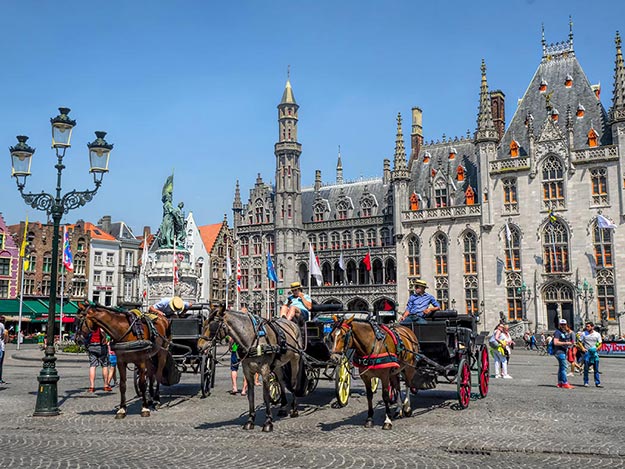
Amazingly, the old guild houses and canals have survived two World Wars nearly intact. Today the town exists mostly on tourism, and if I have one criticism it is that the city is very touristy. The squares are chock-a-block with crowds and seats are at a premium (as are the prices) at the many restaurants that surround them. Tour boats putter down the canals every few minutes. But like most touristy destinations, it simply requires getting off the beaten track to get a true feel for the city. Our tour guide showed us a few places, and I ferreted out a few more by staying behind for a few hours rather than returning to Brussels with the group. By the end of the afternoon, most day-trippers had departed, and I was able to snap a photo of Markt Square without throngs of tourists. The day tour I took was excellent, however next time I’ll wander solo, perhaps with the assistance of this weekend in Bruges itinerary.

Ghent: Rich in history and culture
Faced with limited time, tourists often bypass lesser-known Ghent in favor of Bruges. This, in my opinion, is a huge mistake. Ghent is a must on any list of places to visit in Belgium. Art installations in Ghent range from the famous “Adoration of the Mystic Lamb” (also known as the Ghent Altarpiece) by Jan and Hubert van Eyck, to one of the most vivid displays of street art in Europe.
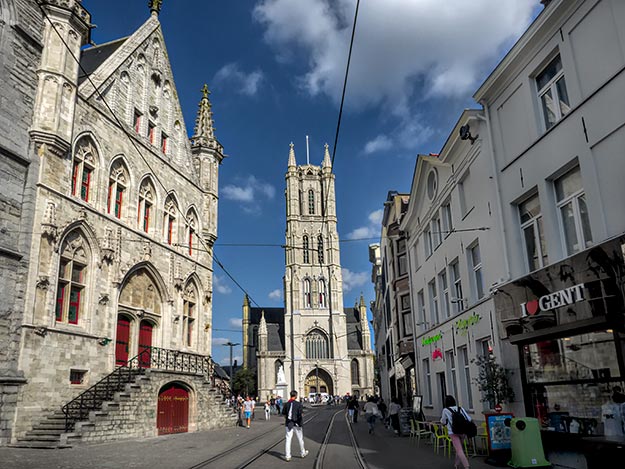
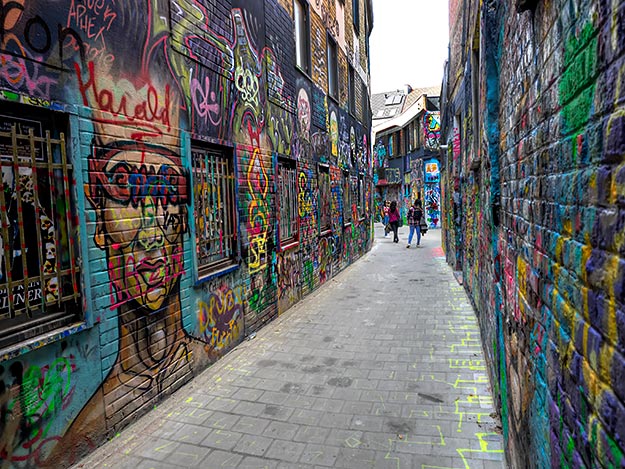
The calendar is chock full of festivals, including favorites like the Light Festival (held once every three years), a multitude of concerts, and a film fest. Ghent has been acclaimed for its unique lighting plan, which makes the city come alive after dark. Even the food scene is one of the most progressive in the world. With more vegetarian/vegan restaurants per capita than any other city in the world, Ghent is a paradise for veggie lovers.
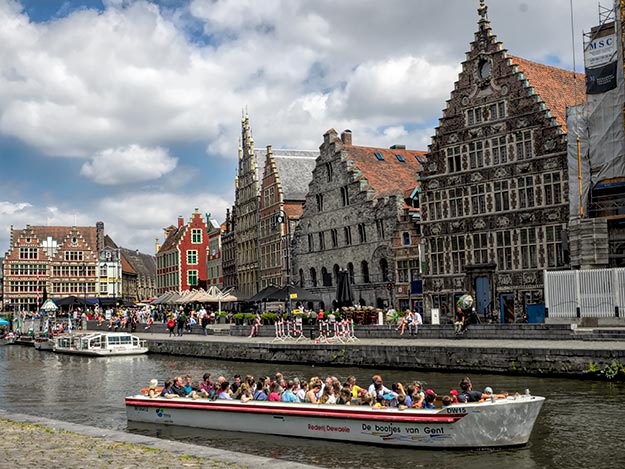
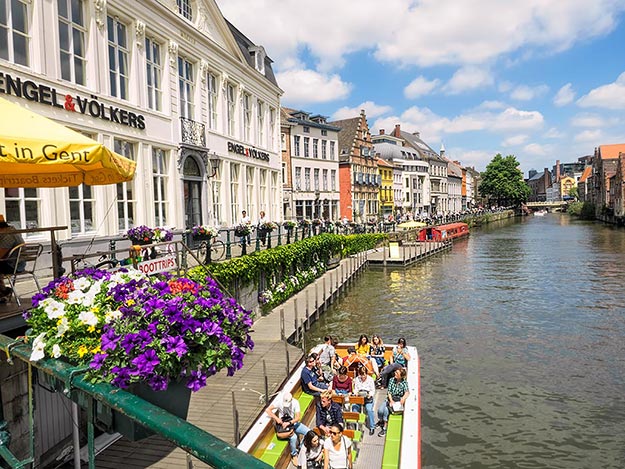
Frankly, I was gobsmacked by Ghent. I spent two entire hours touring Gravensteen Castle, a magnificent 12th century castle that once stood on the outskirts of the city but is today surrounded by it. The views over Ghent from the ramparts are not to be missed! Like Bruges, Ghent is a wonderland of canals, however it seems more sedate than its counterpart. There are fewer tour boats plying the waters, fewer vendors hawking caricatures, and not much in the way of crowds. How Ghent has escaped the notice of the tourist hordes is a mystery, but it seems to have done just that.

Where to stay in Belgium: Brussels, Bruges, or Ghent?
It’s an age-old debate: which cities to visit and where to stay in Belgium. I chose to base in Brussels and do day trips to other cities, including a day trip to isit the WWI sites of Flanders. But if I had the opportunity to do it over, I would stay in Ghent. From Ghent, trains reach Brussels, Bruges, and even Antwerp in 30 minutes or less, and they run frequently, well into the night. Unless you’re looking for an all night party (in which case Brussels may make better sense), accommodations and food are more affordable in Ghent and the atmosphere is much more enjoyable.
Disclosure: My day tour of Bruges was provided complements of Sandeman’s New Europe. However, the receipt and acceptance of complimentary items or services will never influence the content, topics, or posts in this blog. I write the truth, the whole truth, and nothing but the truth. This article contains affiliate links to hotel booking sites. If you click on any of the links and make a booking, I may earn a small commission, which keeps this blog free to read.

Thanks for some new tips for my next visit to Belgium. For a few days at the seaside I recommend DeHaan. Located 90 km from Brussels. From here one can visit Knokke by streetcar or in a short drive reach Bruegge. De Haan is styled like a British coastal village.
Thanks so much Robert. I’ve long wanted to visit the seaside in that part of the world, so I’ll put this on my wish list.
As usual Barbara I really enjoy your articles, especially your photography. What camera are you using? I usually focus on Asia but have wanted to visit Belgium for years. Thanks for taking me along on the trip, so to speak. A former tenant is part Belgian and part French and has been involved with the food world since she was 13.
Hi Audrey. A couple of years ago I ditched my entire DSLR (Canon) kit and went to a mirrorless camera, the Olympus OM-D E-M1. I couldn’t be happier. It’s lighter than DSLR’s and gives me much better photos. Most professionals are switching over to the mirrorless.
What a great article, Barbara! Like you, I enjoy out-of-the-way places, not packed with tourists, so your info on Ghent was fantastic. And, you pretty much HAD to try the chocolates, after all, if even to test that Belgium chocolate was b-e-t-t-e-r…lol
As always, I’m so grateful for your comments. And your support over the chocolate, of course 🙂
Ghent and Antwerp have been on my To Go Soon list for years, and hearing that Ghent has the most veg restaurants per capita has galvanized me! Thanks for that. I’ll plan for at least a week in Ghent on my upcoming trip.
Oh I’m sure you’ll love it Laura. It’s on my list now as a place to revisit, and very few places make that list.
Love all three of these cities, like you we particularly enjoy Ghent, perhaps as it gets fewer visitors than the other two. We may need to return to check out the evening lighting plan (any excuse).
However, all three produce lovely chocolates.
Happy Travels
Janis
And I availed myself of chocolates in all of those places, I’m afraid 🙂